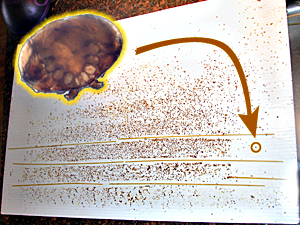 And on the fifth day (which would have been Friday), she counted. And what did she count? Nasty little pin-head sized mites, my dears. By the hundreds.
And on the fifth day (which would have been Friday), she counted. And what did she count? Nasty little pin-head sized mites, my dears. By the hundreds.There is only one way to find out if a treatment for varroa mites is working (or isn't working, or whether you should be working on putting together a treatment): you count mites. In my case, I count the mites that fall down from the hive onto a greased up bottom board below it.
I felt sorry for myself three weeks ago (before it was clear that there was a problem): the bottom boards came out, and there were about 150 mites to count on the worst one. It's a very nit picky business (to mix buggy metaphors), because the mites are so tiny and the bees tend to drop a bunch of other stuff, too, like pollen grains, wax flakes, ex-bee body parts, and unidentified beekeeping objects.
To my earlier self, I now say "Hah!" If you have a good treatment going, you will get hundreds to fall every day, at least at the beginning. After four days exposure, the board from Wilde pictured above contained 814 dead varroa mites (by my count). The board from Twain, surprise surprise, totalled 1514! This is a lot of mites by anyone's calculus, and kinda hard on a poor aging beekeeper's eyes.
The boards are about 2 feet by 18 inches, and I kept getting lost ("Have I counted this mite before? Where did I stop last time?"), and needed a way to mark out territory. Therefore, I have developed the Spaghetti Method (TM) for counting Dropped Varroa Mites. You, however, are hereby licensed to use this technology for your own apiary endeavors if you think nice things about my bees while you use it.
It works like this: the stuff on the bottom boards tends to fall in a way that shadows the frames of bees hanging in the boxes above. Basically, there are rows of assorted crud that overlap a bit. Grab some dry spaghetti (use the straightest ones you can find) and use it to mark off the spaces between rows, pushing the odd mite to one side or the other if you need to. Make sure you count any mites that end up stuck to the spaghetti (there is absolutely not a single cooperative feature of a varroa mite, I assure you). Take a little broken bit of pasta to use as a pointer, and begin working your way along each row, poking around in little blobs that might conceal a mite. Write down your count for each row, then total all the rows when you finish.
By the way, I could go all legal on you and tell you not to eat the pasta afterward, but it's probably safe if you did not use some kinda funky oil on your bottom board. Buon appetito.
The folks on the Beesource bulletin boards seem to think my daily mite counts were in line with an ongoing treatment (203 and 379 for Wilde and Twain respectively), but some thought perhaps a fourth application would be in order. I just completed the third, and possibly final, treatment today, and kind of want to know if this is "too much of a good thing" territory. Therefore, you can guess what's coming next week: another mite count.
So Tuesday, otherwise known as Valentine's Day, I'll be up on the roof, placing clean sticky boards. It's just as well that I lurk up there, because that Animal Planet show for which we (the girls and I) were interviewed is airing that day.
2 comments:
http://animal.discovery.com/tvlistings/series.jsp?series=116724&gid=0&channel=APL
PLEASE don't look at my hair.
Wonder if it would work to draw a grid on the sticky board with permanent markers - you could then have the spaghetti for dinner instead!
Post a Comment